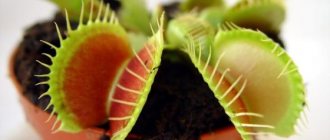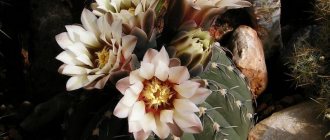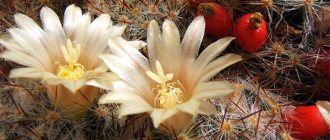Many people associate cacti with the desert, hot sun, rocky terrain and constant drought, which leads to a large number of mistakes in caring for these plants. In addition, each individual species has its own characteristics and requires certain maintenance conditions. In fact, everything is not so complicated, and any cactus can become a real decoration for your home if, before purchasing, you study the types of these indoor plants and find out what climate and conditions are typical for the homeland of this or that cactus.
The first mentions of cacti
Before botany became a systematic science, many plants were mistakenly considered related. Various succulents were called cacti (from the Latin succulentus - “succulent”), and varieties that did not have thorns were classified as a different species. At the end of the 16th century. Flemish scientists presented a reliable image of one of the melon cacti. Following them, the botanist Carl Linnaeus first used the term Cactus (ancient Greek κάκτος - “thistle”) in relation to this plant, which gave the name to the whole family.
The cactus came to Europe after its first travels to the New World and soon became a popular exhibit in private botanical collections. Some pieces were worth twice as much in gold equivalent as they weighed.
Cactus - indoor plant
- Rainbow Echinocactus is an oval or cylindrical species with a height of up to 45 cm. Impressive for those who want to know everything about cacti, its color scheme is pink and purple.
- Gymnocalycium Michanovich is an incredibly beautiful cactus variety that blooms quite early with funnel-shaped, pink, red and white flowers. The wide and elongated stem of a brownish or gray-green hue in such a plant contains up to 10 thickened, triangular ribs, but there are no fibers.
- Cleistocactus Strauss is a columnar, horizontal variety of cactus that is covered with hairs. The height that this cactus can reach is 1 meter. A peculiarity of this plant is the flowering of closed tubular flowers.
- The small-haired prickly pear, if you read the message about this plant, will not allow you to touch it. The miniature spines with jagged tips cause a painful prick. Prickly pears can grow up to 30 cm and have different shapes.
- Mammillaria is a plant that has up to 500 varieties. Mammillaria are usually covered with soft, long, hair-like spines. The stems of this cactus are spherical or cylindrical.
- Rebutia tiny is a cute little cactus with a spherical shape, the diameter of which is no more than 10 cm. Rebutia differs from other varieties of cactus in the placement of flowers - not at the top of the stem, but near its base.
Which country is considered the birthplace of the plant?
Scientists believe that the homeland of the cactus is South America and the Caribbean islands, formerly called the West Indies. There it arose more than 30 million years ago in the form of a mesophytic dicotyledonous flower. By the time of the emergence of ancient Mesoamerican civilizations, he changed the exterior to one more resistant to hot climates.
From Aztec legends deciphered by ethnographers, it is known that prickly pear, called “nopal” by the indigenous inhabitants, was used in everyday life, eaten and was an object of cult, a symbol of the mercy of the gods. The plant is depicted on the modern coat of arms and flag of Mexico. To this day, in the markets of this country, the fruits of prickly pear, Echinocereus and Pilosodereus are sold as street food.
Basic rules of care
Before you start growing or collecting cacti, you need to carefully study the information about the rules for caring for them. In general, care comes down to watering, correct temperature, grafting and replanting.
Selection of capacity
First of all, you need to choose the right container. The plant's homeland has given the cactus a rather capricious nature, so the size of the pot must clearly correspond to its root system. In order to correctly determine the size of the required container, remove the sprout from the container, straighten its roots and inspect their branching. In some cacti, the root system is more developed in the upper part, so the root length is short. For such sprouts it is better to choose wide and shallow pots.
Those varieties of cactus whose roots grow long require a deep pot. When choosing a container, also consider the nature of plant propagation. Species such as mammillaria (the largest variety) form a large number of “babies”, so many small plants appear in the pot. In these cases, it is necessary to use wide pots.
Attention! You should not use metal containers, as rust can have a detrimental effect on the cactus.
.
Soil selection
Preparing the land for replanting a cactus is a responsible and important process. The choice of soil is influenced by many factors, such as the type of cactus, the homeland of the plant, and its age. There are several recipes for preparing soil, but the constant ingredients remain leaf, clay-turf, old greenhouse soil, humus, coarse river sand, charcoal and brick chips. The soil for the plant is chosen based on your experience and preferences, but the main condition remains the looseness of the soil and its acidity of no more than 4.5-6.
Related article: What tradescantia looks like
Drainage
In the case of a cactus, drainage is a must, since stagnation of water in the root system can lead to the death of the plant. The size of the drainage holes may vary, but should not exceed 1/6 of the volume of the pot. As a drainage layer, you can use small pieces of red brick, expanded clay, crushed stone or, in extreme cases, foam plastic.
Temperature and lighting
The plant’s homeland is sultry America, so the cactus cannot exist without bright and natural light. Lack of light can lead to damage, diseases of the stem and its eventual death.
Plant “hedgehogs” should be placed on the windowsills of south-facing windows, in bright places where they will receive direct sunlight. In winter, it is advisable to increase lighting with daylight lamps. To determine whether a cactus has enough light, you need to look at its top. If it is elongated and thinner than the main stem, it means the plant is not receiving enough light.
Cacti love direct sunlight and feel great on the windowsill
Do not move the plant from place to place or rotate the pot to ensure uniform growth - this may interfere with flowering. Cacti love fresh air very much, so at the first warming, acclimate it to the outdoor climate.
The optimal temperature in winter is not lower than 8-12 degrees
Necessary environment for growth
Although succulents are resistant to dry air and prolonged absence of moisture in the soil, they are difficult to tolerate drafts and hypothermia.
Considering the homeland of the cactus, do not allow the plants to fall into conditions where the air temperature is below +6°C.
In the summer, provide them with as much sunlight as possible, and in the fall, when the days become shorter, it is recommended to irradiate indoor cacti at home with an ultraviolet lamp for several hours a day.
In winter, cacti slow down their development and enter hibernation mode, during which their outer cover becomes thinner. Therefore, in the spring you should avoid direct sunlight on the plant for some time.
If it overheats, it must be sprayed with cool water. Otherwise, burns may occur on the skin.
How to determine the age of a cactus?
If you read the information about a cactus, its age is determined not by years, but by wintering or dormant periods.
If, for example, for 3 years the cactus grew in the same conditions: at the same air temperature, humidity, lighting - then all 3 calendar years are counted as one year of the plant’s life.
Wintering for cacti most often occurs when the temperature is below 18-20 degrees. At this temperature, the life processes of the cactus freeze, and at this time it does not require watering or care. As the air temperature rises, the cactus begins to come to life and this time is considered the beginning of a new year in the life of the plant.
Ideal soil composition for indoor cactus
In order for the plant to produce flowers on time and not lose its attractive appearance, you need to choose the right components for the soil. The soil should allow moisture and air to pass through and give a slightly acidic reaction (not higher than 6.5 on the Ph scale). The soil must contain small pebbles, brick chips or coarse sand to provide drainage at the roots, otherwise putrefactive processes will begin.
A small amount of peat and greenhouse substrate will give the plant the necessary nutrition, rich in microelements.
The composition of the soil in which the cactus will grow properly must be balanced in each case differently:
- Ariocarpus, Astrophytum, Lophophora and other desert specimens require twice as much turf soil as leaf soil.
- Large cereus cacti need humus, which is added in a ratio of 1:4 to the amount of peat.
- Adult cacti should grow in denser soil, the main part should be greenhouse soil and clay-turf soil.
- Cacti with long spines need calcium supplements. Finely crushed eggshells will do.
Coal will prevent the roots from rotting, but it should be remembered that it alkalizes the soil. The admixture of clay in the soil blocks the excessive release of moisture from it.
You should not add too much humus or nitrogenous fertilizers - most cacti do not need growth stimulation.
Creating natural conditions for indoor cacti
Despite the fact that the flowers come from America and are adapted to drought, you need to know some nuances in care so that the plant blooms regularly and does not get sick.
Lighting and temperature
During warm periods, it is advisable to place plants on a loggia or veranda.
Advice!
In winter, experts recommend moving flowers to a place with a temperature of no more than 18 degrees and ensuring high air humidity, since this part of the year is considered a dormant period.
These plants love a lot of light, so it is recommended to place them on window sills on the sunny side of the house, and use lamps in case of insufficient lighting. Experts recommend giving preference to southern and eastern windows.
You may be interested in:
Monstera: home care, replanting and propagation of plants Monstera is interpreted as amazing or bizarre. The homeland of this vine is the subtropics, rich in moisture and warmth.... Read more...
Watering and fertilizing
It is recommended to water the flowers with melt or rain water. If this is not possible, then you should give preference to filtered water. In spring and summer they are watered daily or every other day. In autumn, watering is reduced to once every 7 days, and in winter, the plant will only need one watering every two weeks.
Watering a cactus
For feeding, choose fertilizers with a high content of nitrogen, potassium, phosphorus and calcium. Feeding is carried out during the growth period, that is, in spring and autumn. Experts do not recommend fertilizing plants with damaged roots.
Transplantation and propagation
When replanting, it is very important to choose a pot that is the right size. To do this, remove the flower from the container and look at the size of the root system. The size and shape of the pot will depend on it. It is not advisable to buy metal containers, as corrosive processes can affect the condition of the flower.
Transfer
The soil should contain leaf, old greenhouse, turf and clay soils, humus, sand and crushed charcoal. In addition, the acidity of the substrate should not exceed pH 6.0. The pot must have drainage holes so that excess water does not stagnate when watering.
The most common method of propagation is by cuttings and children. To do this, the baby or cutting is disconnected from the mother plant and disinfected. The shoot is placed in a container of water. When roots appear on the shoot, it is dried for several days and rooting begins. To do this, prepare a substrate with a high sand content and plant the shoot without filling the neck. Place the pot in a cool, dark place for several days. After rooting, the young flower is “accustomed” to normal conditions.
Diseases and pests
The most common diseases of fungal origin are wet and dry rot. The disease initially hardly manifests itself, as it develops from the inside and gradually spreads to the outside. The disease occurs due to excessive watering. For treatment, damaged areas are cut off and the plant is treated with fungicides.
Among the parasites, spider mites, nematodes and scale insects are often found. Their presence can be determined by the larvae and bugs on the vegetative part. Broad-spectrum insecticides are used for treatment.
Evolution of species
The predecessors of the cactus arose in the era of a single continent, when the climate in the area of origin was mild and humid. They had leaves that later transformed into needles. The split of the continent led to a shift in territory, and the habitat changed to a more severe one, with prolonged drought and heat.
Leaves became unprofitable under these conditions because they evaporated too much water. During evolution, they began to thicken and become covered with a protective shell, under which they stored moisture. In habitats with a large number of animals, the spines lengthened and became hard; in less populated areas they remained soft to better absorb dew.
Features of the cactus
- The stem of many cactus species is formed by a rib or papillae. The ribs are high, low, wide and narrow. Most often they are located vertically.
- Areoles are a place characteristic of cacti where hairs, spines, piles, shoots and flowers develop. Almost all decorative and unusual cacti have shoots and flowers at the top of the areola, and spines at the bottom.
- The thorn is the best decoration of a cactus. Many scientists have been able to prove that this part of the plant appeared as a result of modification of the leaves. The spines can be of different types: hair-like, bristly, awl-shaped, needle-shaped and club-shaped. They also come in flat, faceted and “paper” shapes.
- When describing a cactus, it should be noted that some varieties of this plant also have leaves. They can have a solid oval leaf plate, which allows them to remain on the plant, and also be modified - cylindrical in shape.
- The fruits of the cactus are berries. Their size varies from a few millimeters to several centimeters.
Why is the cactus prickly?
- A unique feature that the thorn has is the magnetization of water droplets to itself due to electrostatics. In this regard, cacti do not always wait for rain to be properly nourished.
- Having acquired spines, the cacti also became concerned about their own safety. Damaging facts confirm that a large supply of water is stored in this plant. And many animals are ready to feast on the cactus. In such a situation, you can protect yourself with the help of thorns, which no animal can handle.
- The spines on the cactus also help it pollinate. Thanks to them, a special nectar is released that pollinating insects like.
Why are cactus babies round?
Small round shoots are necessary in order to roll away from the cactus to a long distance. If the cactus babies do not separate in time, they will stretch out and become oblong.
Read also: Everything about the orchid, what it looks like, species, where it grows, reproduction, interesting facts
When the baby falls away, it begins to grow next to its parent. This is why in nature cacti grow in groups.
Routes to Russia
After Columbus's first voyage around the world, active exploration of the lands of the New World began. In addition to spices, hunting trophies and luxury goods, little-studied plant species, including cacti, began to arrive in Europe.
With the development of apothecary business under Peter I, exotic succulents began to be imported to Russia.
Doctors invited from Europe were by that time aware of the medicinal properties of aloe and used it in their practice. Following these plants, prickly pears and euphorbias entered the Apothecary Garden established by the emperor by the middle of the 18th century. From the records of the Medical Chancellery it is known that some of them were sold to private individuals.
In subsequent centuries, cacti were also imported by Russian travelers exploring the lands of South America. Thus, the Russian ethnographer G. Langsdorff and botanist L. Riedel, who traveled through the Amazon, transported several thousand living specimens to their homeland.
Cactus propagation
- The simplest and most popular method of breeding cacti is the use of “babies” or shoots. Under normal conditions, a plant can be propagated by “children” thanks to wild animals. If the cactus has spines, the babies, like burdocks, cling to the fur of animals, after which they quickly cover long distances.
- Some varieties of cacti do not have shoots, and therefore they can only be propagated by seeds or cuttings.
- The most difficult method for breeding a cactus is grafting. This method is used only in extreme cases, for example, when you need to save a rotting flower.
Read also: Facts about fly agaric, features, species, where they grow, application, selection tips, interesting facts
Current distribution area
The usual habitat of most species of cacti is North and South America, but in Central it is practically absent. Argentina, Paraguay, Uruguay, Bolivia, Chile and Peru, the Caribbean countries and the humid regions of southern Brazil are richest in different species. From their places of origin, they were brought by humans to other continents and islands, where the climate allowed some species to take root - these are Africa, Sri Lanka, Zanzibar and Madagascar.
Prickly pear in Eurasia has developed resistance to snow; it can be found in Greece, Turkmenistan and the Krasnodar Territory, in the North Caucasus. Considering the unpretentiousness of this species and its ability to tolerate frost, it can be assumed that prickly pear will continue to spread throughout Russia.
Main types of cacti: country of origin determined the development of varieties
Photo from the site: flowertimes.ru
Despite the fact that the cactus originates from the hot and arid areas of Central and South America, it has become a familiar inhabitant of many domestic apartments. And, oddly enough, it took root in wildlife quite quickly. In our area, cactus flowers, whose homeland is Argentina and Bolivia, can be found in the Crimea, especially in the vicinity of Sudak, and some particularly tenacious members of the family have managed to take root even in the Astrakhan region, where the ambient temperature sometimes drops to minus twelve degrees Celsius. . Experts classify all such plants into four large groups, which are worth understanding a little.
- Opuntiaceae are distinguished by rather simplified, reduced leaves, as well as extremely thin and brittle spines that are covered with tiny serrations.
- Found exclusively in their native Patagonia, they are very small and their foxes grow no more than ten millimeters in length.
- Pereskia species have fully-fledged leaves. Scientists consider such species to be a kind of connecting link between cacti and ordinary leafy plants.
- The most common species in the world are, in fact, cacti, which are securely “nestled” on our windowsills. For the most part, these species have a spherical or cylindrical shape, are covered with spines of different sizes, and bloom with magnificent flowers in the shape of a raster.
Photo from website: Xcook.info
It is remarkable that many indoor cacti, whose homeland has long become blurred and uncertain, can be used as a basis for shampoos, medicines, due to their beneficial qualities and properties; perfumes and hormonal products are also made from them. Many tasty and nutritious dishes have already been invented from prickly pear; all parts of the plant are suitable for food, and candied fruits, extremely rich in vitamins, are even made from melocactus and echinocactus.
Variety of shapes and types of cacti
What do we most often imagine when it comes to cacti? Of course, a prickly spherical thing that causes a state close to panic in young mothers and pet lovers. In reality, cacti amaze with their variety of shapes and sizes. In the natural environment, there are completely non-thorny giant specimens, reaching a height of several meters, and dwarf cacti with a very short body, for example, Rebutia.
Common stem shapes are spherical, cylindrical, candle-shaped, disc-shaped. There are even atypical forms: monstrous, when a large number of lateral shoots appear, and cristate, formed due to the proliferation of the apical growth point. The reasons for their development have not been precisely established. Some species (for example, Pereskia) even have a woody stem and ordinary leaves.
IN THE PHOTO: Cristate form of Mammillaria
Cacti are characterized by a long lifespan and slow growth. In nature, they can live from several tens to hundreds of years. The shortest lifespan of plants of the genus Frailea is about 10 years.
The homeland of cacti is America, where they are distributed everywhere - from Canada to the southern regions of Chile, Mexico is especially rich in various species.
In the Old World, cacti are not found in the natural environment, except for some species of Opuntia, brought by humans to Australia, India and the Mediterranean countries. The epiphytic cactus Rhipsalis, common in Sri Lanka, Madagascar and western Africa, was also presumably brought there from America in ancient times.
IN THE PHOTO: You can never have too many prickly pears
Cacti are divided into two large groups - desert and tropical; keeping them at home is significantly different.
Flowering cacti.
When these prickly balls and columns bloom, it is an extraordinary spectacle of amazing beauty, a real symphony of color and paint.
The flowers of the serpentine cactus Queen of the Night are famous for their splendor. As you know, each plant has its own soul and its own fairy tale. And this amazing cactus has it. Everyone was invited to the ball at the queen of flowers - Rose - including the unsightly-looking snake-like cactus, which was embarrassed by its prickly ugliness and clumsiness against the backdrop of its regal splendor. He resignedly endured all the injections and ridicule addressed to him. Huddled in a corner, he did not take his admiring eyes off the queen. Night was approaching, the ball was in full swing, and then, as expected in a fairy tale, a miracle happened. The gathered flowers did not immediately understand what was happening. From the corner in which the cactus, rejected by everyone, sat, a mysterious, gentle, translucent light slowly began to emanate, which became brighter and stronger. Before the eyes of the amazed public, a flower of fabulous, indescribable beauty opened: large, pure white with golden stamens. Everyone froze in silent admiration. This stupor lasted until dawn, when with the rays of the rising sun the flower closed, and everyone saw that it was the same cactus about which they had so venomously joked. But now he no longer seemed ugly and disgusting to anyone. Everyone was impressed by the miracle he performed. Since those fabulous times, in all languages of the world this cactus has been called the Queen of the Night (Latin - Selenicereus granndiflorus, from the Greek selena - Moon).
Queen of the Night cactus blooming
With proper care, many cacti can delight you with their flowers. At home, leaf-shaped phyllocacti bloom most often and profusely.
Cactus flowers consist of pedicels, sepals turning into petals, stamens and pistils (bisexual). Flowers appear on the stem. In several groups, cephalia (cephalus - head) are formed on the stem - special zones on which flowers are formed (for example, in representatives of the genus Melocactus). The sizes of flowers are very diverse. Thus, the already mentioned Selenicereus (Queen of the Night) forms flowers the size of a plate (up to 32 cm in diameter) with numerous petals. The flowers of the cactus Hylocereus polyhrizus reach 40-45 cm in length. And there are cacti that form very small ones, less than a centimeter in diameter with a small number of petals (4-10).
Cactus flowers are often solitary. Their symmetry is either radial or bilaterally symmetrical. In the color of cactus flowers you can find all known colors and shades, except blue and black.
Cacti have different flowering abilities: some produce two or three flowers per year, others can be completely covered with flowers. Some can bloom all year round (with certain soil nutrition, humidity, light), others delight with their color for only a few hours. Some bloom, opening and closing according to the cycle of day and night, while others retain their flowers for only one night. Some exude a subtle aroma, others have no smell at all. Some have wide-opening flowers, while others have flowers that look more like narrow tubes.
The part of the flower from which the fruit will develop is located below the petals, that is, cacti have a lower ovary - this is also a sign of their family relationship. Dried petals can often be found on ripe fruit.
After fertilization, cacti produce a wide variety of fruits in shape, color and structure. From a large juicy berry the size of a lemon to a dry small box with seeds. The fleshy, juicy fruits of cacti are usually edible. Thus, the fruit of Eriocereus is surprisingly sweet and pleasant to the taste. Cacti strewn with bright fruits will decorate your collection no worse than flowering plants.
Cactus fruits
Transplanting cacti
The cactus needs to be replanted only when it becomes cramped in the pot. This procedure is carried out in the spring, when the period of intensive growth begins. 2-3 days before replanting, the cactus should be stopped watering, as the soil should freely fall off the roots. In order to avoid injury from the cactus, it must be wrapped in several layers of paper or high-density fabric.
Young specimens require an annual transplant, and those that are 3 or 4 years old need this procedure once every few years.
The container for planting must be chosen compact, so that the root system fits into it, and there is no empty space. Place a drainage layer on the bottom of the pot and add a small amount of substrate. After this, you need to hold the plant with your hand and lower its roots into the container. At the same time, you need to slowly pour the soil into the container with your other hand until it fills the pot. In this case, the soil surface should be one centimeter below the edge of the container. The base of the stem should not be buried in the substrate. In order to pour the soil into the pot more tightly, you need to systematically tap on its walls. The optimal composition of the soil mixture for this plant is: washed river sand, peat, leaf soil and charcoal. The soil needs to be slightly acidic and loose. If desired, you can purchase soil mixture for cacti in a special store.
The history of the cactus
Cacti are perennial plants belonging to the Carnation family. The history of the appearance of the prickly plant is still shrouded in mystery. It is noteworthy that their fossil remains have not yet been discovered, so one can only guess about the true origin of the cactus.
Scientists suggest that they appeared more than 30 million years ago. Most likely, the family's homeland is the arid regions of South America or the West Indies. Images of plants similar to modern varieties have been found on ancient Aztec bas-reliefs and cave paintings.
Apparently, their ancestors were moisture-loving plants with well-developed leaves, such as vines. Over thousands of years, cacti have adapted to the peculiarities of climatic conditions, developed and formed external characteristics. Plants that failed to adapt to deteriorating natural conditions died out, while other species survived by reducing their leaves. Gradually their new forms appeared, in many cases becoming succulent.
Where do cacti grow?
The distribution range of cacti is very wide, but they are considered primarily typical inhabitants of the deserts of North and Central America. Mexico and the southern states of the United States are classic areas for the distribution of cacti. Mexico and cacti are generally inseparable concepts. Cacti of all known forms are found here; both dwarf and giant specimens; a wide variety of species is represented. Cacti here have long fed and clothed Mexican peasants. Since ancient times, the cactus has been one of the symbols of the Mexican coat of arms. And the name Tenochtitlan (the ancient capital, on the site of which modern Mexico City flaunts) translated means “place of the sacred prickly pear.”
Habitat of cacti
Interesting Facts
- The medieval navigator Christopher Columbus in his notes says that the indigenous people of America he met ate melon. In fact, the Indians ate cactus.
- Cacti serve as raw materials for the production of alcoholic beverages, cosmetics, food products, including confectionery, medicines, soaps and much more.
- The tiniest cacti in the world are called Blossfeldia, whose maximum height is only 1-3 centimeters.
- The largest cacti in the world are Californian cereus, whose age can reach 150 years and height - 20 meters.
- Scientists have proven that the spines of the plant have the property of ionizing the air.
- In ancient times, plant needles were successfully used for medicinal purposes, for example, to stitch up deep wounds.
- Some plant species feed on insects. Thanks to their specific aroma, they attract small insects and then eat them.
- Cows that eat the thorny plant produce more milk.











